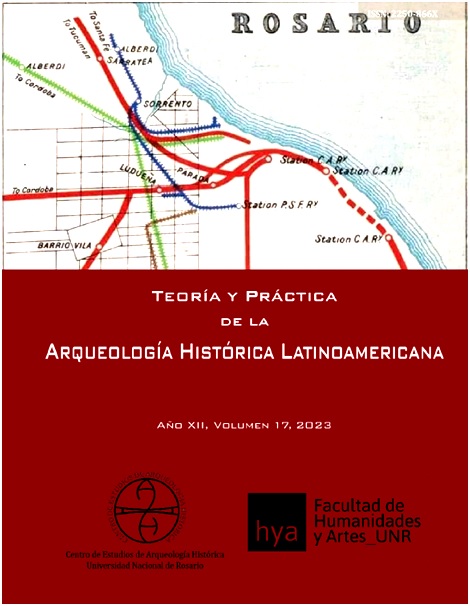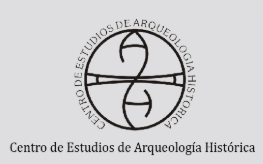Cheap and scarce: earthenware decorated with sponge in Rosario, Argentina (1870-1900)
DOI:
https://doi.org/10.35305/tpahl.v17i1.205Keywords:
Urban archeology, crockery;, RosarioAbstract
Ver detalles 957 / 5.000 Resultados de traducción Resultado de traducción The decoration on domestic industrial ceramics during the 19th century was very varied and responded to a system of production, distribution and consumption. Rosario, as an emerging city, with the introduction of capitalism in 1870 in Argentina, could not remain alien to that system and the archaeological record can indirectly reflect that general context, but articulated to the local one. A group of earthenware – those decorated with sponge or sponged – despite their apparent quantitative insignificance shows how European industrial products reached a city that, at that time, was in the process of both economic and social change. The global and local transformations of the market can be read in this small archaeological complex, which belongs to the last three decades of the 19th century. The objective of this work is to show these socioeconomic processes through these fragments recovered from Rosario garbage dumps.Downloads
References
Andrade Lima, T. (1995). Pratos e mais pratos: loucas domésticas, divisioes culturais e limites osciais no Río do Janeiro, século XIX. Anais do Museo Paulista 3, 129-191.
Boa, V. N. S. (2012). Clyde Pottery Wares in the McLean Museum Collection.Recuperado de: https://www.inverclyde.gov.uk/assets/attach/7460/Clyde-Pottery-Wares-in-the-McLean-Museum.pdf. Últimoacceso: 11 dediciembre de 2021.
Boness´Pottery. The Industry of e pottery of Borrowstounness. (2009): Mary Finlay. Recuperado de: http://bonesspottery.co.uk/fim.html. Último acceso: 14 de marzo de 2022.
Brooks, A.; Urbina, S.; Adán, L.; Carabias, D. Sepíulveda, V. Chiavazza, H. y Zorrilla, V. (2019). The Nineteenth-Century British Ceramics Trade to Southwestern South America: An Initial Characterization of the Archaeological Evidence from Chile. En: C. E. Orser Jr. (ed.). Archaeologies of the British in Latin America Contributions To Global Historical Archaeology. Springer International Publishing. 55-71.
Campbell, H. (1982). Spongeware.Historical Review 1982-1983. Coburg, Ontario, Canada: Cobourg and District Historical Society. 37-39.
Campbell-Green, T. (2011). The Rough Guide to Pottery Pt.2 – Spongeware. The Glossop Cabinet of Curiosities. Recuperado de: https://glossopcuriosities.wordpress.com/2022/02/11/the-rough-guide-to-pottery-pt-2-spongeware/. Ultimo acceso: 3 de noviembre de 2021.
Cruickshank, G. (1985). Scottish pottery. Princes Risborough, ReinoUnido: Shire Books.
Diagnostic Artifacts in Maryland. (2012). Sponged decorated wares. Maryland, EEUU: JPPMRecuperado de: https://apps.jefpat.maryland.gov/diagnostic/Post-Colonial%20Ceramics/SpongedWares/index-spongedwares.html. Último acceso: 22 de febrero de 2022.
Dietz, U. G. (1980). A New Look at the Spatterware at Winterthur. Winterthur, Delaware, EEUU: Winterthur Museum.
Dócola, S. (2017). De una aldea sin límites al proyecto de delineación paradefinir una ciudad capital: Rosario 1852-1873. Analesdel IAA. 47 (2), 161-173.
Earls, Amy (2004). A Selection of Cut Sponge Designs, Part 1. Victorian Ceramics Group Newsletter 5 (1). 21-23.
Fernetti, G. (2020). Las lozas decoradas del sitio “La Basurita” como indicadoras de cambio socioeconómico. Rosario, Argentina (1873-1920). Urbania. Revista Latinoamericana de Arqueología e Historia de las Ciudades, 9. 63-92.
Fernetti, G.(2022a). Los platos “Patrón Trigo” (WheatPattern) en Rosario, Argentina (1880-1960) en la evolución socioeconómica de la ciudad. Revista De Arqueología Histórica Argentina Y Latinoamericana 15(1), 8–31.
Fernetti, G. (2022b). Muchas flores, pocos colores. La técnica de decoración por trasferencia en lozas arqueológicas de Rosario, Argentina (1870-1920). Teoría y Práctica De La Arqueología Histórica Latinoamericana 16(1). 93–118.
Fleming, J. (1923). Scottish Pottery. Glascow: Maclehose, Jackson & Co.
Hamer, F. y Hamer, J. A (2004). The Potter's Dictionary of Materials and Techniques. Londres: A & C Black.
Henríquez Ursúa, M., Reyes Álvarez, V., Popovic Silva, V. y Alamos Cardemil, I. (2013). Cerámicas y vidrios. Colección Museo Regional de Rancagua. Andros Impresores.
Hidalgo Gutiérrez, J. (2020) Lozas para el Nuevo Mundo. La presencia de loza fina en el puerto de Campeche (1850-1900). Tesis de grado. Programa de maestría y doctorado en Estudios Mesoamericanos. Facultad de Filosofía y Letras. Instituto de Investigaciones Filológicas. México: Universidad Nacional Autónoma de México.
Hunter, R. (2006). Surfaces of Illusion: Mocha and Spatterwares. En Jane Katcher, David A. Schorsch and Ruth Wolfe (eds.) Expressions of Innocence and Eloquence; Selections from the Jane Katcher Collection of Americana. . 207-229.New haven: Yale University Press
Jarret., C.; Cross, M. y Robertson, A. (2016). Archaeological evidence for the exported wares of the caledonian pottery, Rutherglen, and its role in Glasgow´s ceramic international trade and industry. En: Brooks, A. The Importance of British Material Culture to Historical Archaeologies of the Nineteenth Century. Nebraska, EE.UU.: University of Nebraska Press.
Kelly, H. (1993). Scottish Sponge-printed Pottery: Traditional Patterns, Their Manufacturers and History.Glascow: The Lomondside Press.
Kelly, H. (1994). The Beginning of the Pottery Industry in Greenock. Scottish Industrial History 17. 57-75.
Kelly, H. (2007). Scottish Ceramics. Atglen, EEUU: Schiffer Publishing Ltd
Kelly, H; Kowalsky, A. y Kowalsky, D. (1993). Spongeware: 1835-1935, Makers, Marks, and Patterns. Atglen, EEUU: Schiffer Publishing Ltd
Ketchum, W. (1983). American country pottery. Yellowware and spongeware.Random House USA Inc.
Klose, J. y Malan, A. (2014). An introduction to the identification of ceramics excavated from 18th and 19th century archaeological sites. El Cabo, Sudáfrica: Historical ArchaeologyResearch Group, Universidad de Ciudad del Cabo (UCT).
Langeweg, S. (2004) De techniek van hetversieren: hetdecoreren van aardewerkbijRegout/Sphinx en Société Céramique in Maastricht. Studiesover de sociaal-economischegeschiedenis van Limburg/Jaarboek van hetSociaalHistorischCentrumvoorLimburg XLIX. 97-133.
Lawrence, S. (2003). Exporting culture. Archaeology and the nineteenth century British Empire. En: Historical Archaeology 37(1). 20-33
Liebeknecht, W. B. (2001). Joseph Mayer’s Arsenal Pottery Dump Part 3: Cut Sponge Decorated Ironstone China. Trenton Potteries; Newsletter of the Potteries of Trenton Society 2 (3-4). 1-4.
McCollen, H. (2001). Spongeware and Spatterware. Atglen, EEUU: Schiffer Publishing Ltd.
Majewski, T. y O’Brien, M. (1987). The Use and Misuse of Nineteenth-Century English and American Ceramics in Archaeological Analysis. En Michael B. Schiffer (ed.) Advances in Archaeological Method and Theory 11. Nueva York: Serial Publication Series. Academic Press. 97-207.
Miller, G. (1980). Classification and Economic Scaling of 19th Century Ceramics. Historical Archaeology. 14. 1-40.
Miller, G. y Earls, A. (2008). War and Pots: The Impact of Economics and Politics on Ceramic Consumption Patterns. En R. Hunter (Ed). Ceramics in America.https://www.chipstone.org/article.php/413/Ceramics-in-America-2008/War-and-Pots:-The-Impact-of-Economics-and-Politics-on-Ceramic-Consumption-Patterns. Últimoacceso: 22 de febrero de 2022.
Otte, J. (2019). The trade in European earthenware with the Dutch East Indies 1820-1940. En: VormenuitVuur 241. 2-19.
Prieto, A. (2017). Rosario: la pregunta por la belleza. En Entresiglos: el impulso cosmopolita en Rosario. 1a ed. Ilustrada. Rosario, Argentina: Ediciones Castagnino/Macro. Museo Municipal de Bellas Artes J. B. Castagnino. 17-34.
Robacker, E. F. y Robacker A. F. (1978). Spatterware and Sponge; Hardy Perennials of Ceramics. A. S. Cranbury. New Jersey, EEUU: Barnes and Company, Ed.
Sandling, T. (2018). London in Fragments: A Mudlark's Treasures. Londres: Frances Lincoln Ed.
Sandy, J. y Stevens, N. (2021). Thames Mudlarking: Searching for London's Lost Treasures.Londres: Bloomsbury Publishing.
Schávelzon, D. (2001). Catálogo de lozas históricas de Buenos Aires (siglos XVI - XX). Con notas sobre la región del Río de la Plata. Facultad de Arquitectura, Diseño y Urbanismo. Buenos Aires: UBA
Schvarzer, J. (1996)- La industria que supimos conseguir. Una historia político-social de la industria argentina. Planeta. ColecciónHistoria Argentina.
Stelle, L. J. (2001). An archaeological guide to historic artifacts of the upper Sangamon Basin, Central Illinois, USA. Illinois: Center For Social Research, Parkland College. Recuperado de:
https://virtual.parkland.edu/lstelle1/len/center_for_social_research/english_registry_marks/ARCH%20GUIDE_ENGLISH%20REGISTRY%20MARKS.html. Último acceso: 11 de marzo de 2022
Sussman, L. (1985). TheWheatpattern. An Illustrated Survey. Studies in Archaeology Architecture and History. Ottawa: National Historic Parks and Sites Branch Parks Canada Environment.
Volpe, S. y Fernetti, G. (2018). El Baño de Mandinga (Rosario, Santa Fe, Argentina, 1910): Arqueología de una tierra de nadie. Revista De la Escuela de Antropología XXIV. 1–18.
Volpe, S. y Fernetti, G. (2019). Prospección de basurales históricos de la ciudad de Rosario. Teoría y Práctica De La Arqueología Histórica Latinoamericana 9(1). 19–35.

Downloads
Published
How to Cite
Issue
Section
License
Copyright (c) 2023 Teoría y Práctica de la Arqueología Histórica Latinoamericana

This work is licensed under a Creative Commons Attribution-NonCommercial-ShareAlike 4.0 International License.






